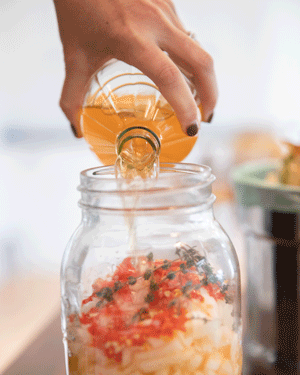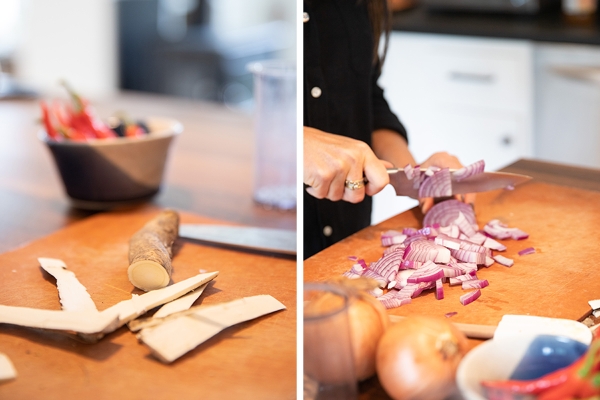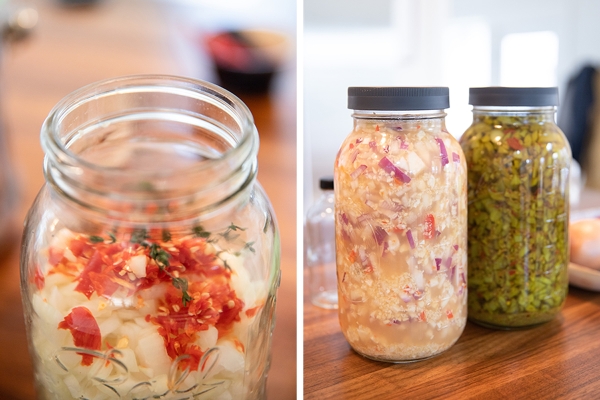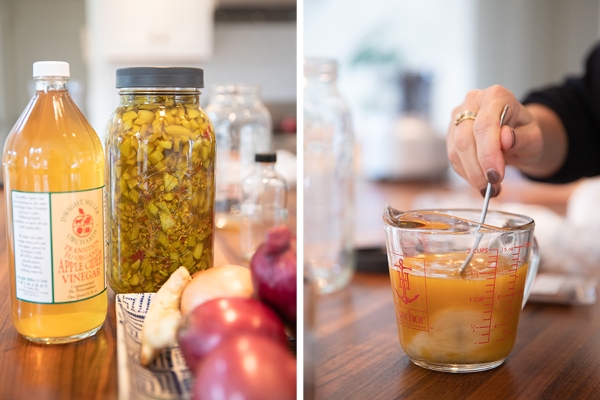Thank you for sharing. Are you going to be able to host the class on line in 2021. I would like to take it and I am sure others would too.
Fire Cider is an oxymel, an herbal preparation made of vinegar and raw honey. Vinegar helps extract the medicinal minerals in plants (as alcohol does in tinctures), and both the vinegar and honey help preserve the preparation. Apple cider vinegar has long been used as a tonic for its wide range of health benefits, including its antimicrobial qualities, minerals, beneficial bacteria, live enzymes, and B vitamins.
Although the preparation has been used for hundreds of years, the name Fire Cider can be credited to Rosemary Gladstar, a well-known herbalist and educator. Gladstar coined the term back in the late 1970’s because of the pungent plants in the recipe. The horseradish, ginger, garlic, onion, and cayenne pepper help ward off infections, cold, flu, and bronchial congestion. In sharing her recipe with thousands of people over time, Gladstar hoped to bring medicinal herbalism back into people’s kitchens and maintain the tradition of freely sharing recipes.
Fire Cider did indeed gain in popularity. Herbalists began creating their own formulas based on Gladstar’s original recipe, and Fire Cider began popping up in farmers markets and herbal apothecaries all over the country. However, in 2014 the herbal tradition was threatened when an herbal company trademarked the name Fire Cider and began demanding that other makers stop selling it. The herbal community mobilized and petitioned, and after a long legal battle, the trademark was revoked. Recently, Gladstar published Fire Cider! 101 Zesty Recipes for Health Boosting Remedies Made with Apple Cider Vinegar, a collection of recipes contributed by a community of herbalists, and another testament to the herbalist tradition of sharing and adapting remedies from generation to generation.
Over the years, Shelburne Farms has hosted Fire Cider making workshops in partnership with Spoonful Herbals, a Burlington-based organization honoring herbal traditions, inspiring ecological stewardship, and promoting wellness through a variety of programs including an Herbal CSA and Herbal Apprenticeship Program. Throughout the seasons, Shelburne Farms shares its campus as an outdoor classroom for Katherine Elmer and Kara Buchanan of Spoonful Herbals to teach apprentices about herbal medicine, the honorable harvest, and how to harvest herbs for their Herbal CSA. Although we could not make medicine together at the Farm this year, I was able to make fire cider a few times this fall with a few close friends. Now you can make it, too!
Rosemary Gladstar’s Original Fire Cider Recipe
makes ½ gallon
Ingredients
- 1/2 cup grated horseradish root
- 1/2 cup or more chopped onions
- 1/4 cup or more chopped garlic
- 1/4 cup or more grated ginger
- Chopped fresh or dried cayenne pepper “to taste.” This can be whole or powdered. “To taste” means it should be hot, but not so hot that you can’t tolerate it. Better to make it a little milder than too hot; you can always add more pepper later if necessary.
- Raw honey
- Unpasteurized apple cider vinegar
- Optional ingredients: turmeric, echinacea, cinnamon, sage, rosemary, thyme, etc...
Directions
- Place herbs in a half-gallon canning jar and add enough raw, unpasteurized apple cider vinegar to cover the herbs by at least three to four inches. Cover tightly with a tight-fitting lid.
- Place the jar in a warm location and let it infuse for three to four weeks. It is best to shake every day to help with the maceration process.
- After three to four weeks, strain out the herbs and reserve the liquid. The strained herbs can be used to make chutney (see recipe below).
- Add honey “to taste.” Your Fire Cider should taste hot, spicy, and sweet. “A little bit of honey helps the medicine go down...”
- Rebottle the liquid and enjoy! Fire Cider will keep for several months unrefrigerated if stored in a cool pantry. But it’s better to store in the refrigerator if you have room. A small shot glass daily serves as an excellent tonic. Or, take teaspoons if you feel a cold coming on. Take it more frequently if necessary to help your immune system do battle.
But wait, don’t compost your strained herbs yet… make some Fire Cider Chutney!
Strain the herbs and veggies from Fire Cider after four weeks. The herbs should still be somewhat firm and flavorful. Add the herbs to a food processor or blender, and grind coarsely (don’t blend into a smooth past, but only until coarse and crunchy). If too dry, add a little of the Fire Cider vinegar to the mix. You might wish to add a little more honey and cayenne to taste. Your finished Fire Cider chutney should be sweet but not too sweet, hot but not too hot, and just right for your taste! This delicious chutney is great on toast, mixed with rice, veggie dishes, is a favorable addition to soups, or enjoyed right from the spoon. It’s the perfect winter condiment!




